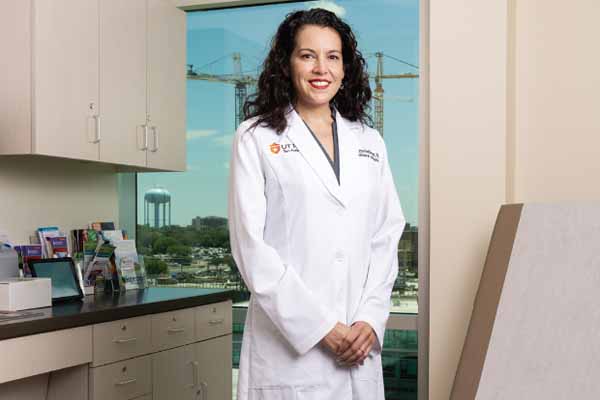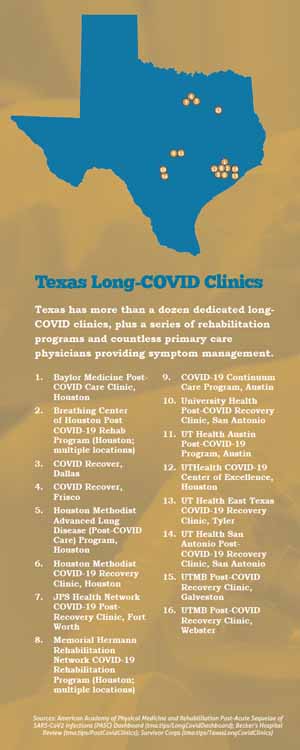
San Antonio physical medicine and rehabilitation physician Monica Verduzco-Gutierrez, MD, opened two long-COVID clinics in August 2020.
The wait time for an appointment at either is three to six months.
This is hard on patients. Some see their long-COVID symptoms abate while they’re waiting to be seen; others lose their job, and with it their insurance, as a result of their symptoms. The intense demand also is challenging for the clinics’ physicians.
“It’s still the stressful split of, ‘I need to see long-COVID patients, and I still have patients with brain injuries and strokes and spasticity,’” Dr. Gutierrez said.
Post-COVID conditions – as long COVID is formally known – represent a wide range of symptoms, including fatigue, shortness of breath, heart palpitations, brain fog, and depression, according to the Centers for Disease Control and Prevention (CDC). These symptoms can last for weeks or months after someone is first diagnosed with COVID-19 and may impair physical or mental function.
Medical experts say long COVID is broad in scope and, so far, fails to respond to a single treatment plan, frustrating physicians, researchers, and patients alike. At the same time, leaving room for discovery is important. Texas Medical Association public health experts say hewing too closely to a narrow definition of long COVID could exclude patients from care – such as those who don’t have a positive test to confirm the original infection – or limit care options.
And these care options are desperately needed. Preliminary studies suggest up to 30% of people infected with COVID-19 develop long COVID. (See “By the Numbers: Long COVID,” page 31.)

Dr. Gutierrez says primary care physicians play an important role in long-COVID symptom management and can help alleviate some of the pressure on clinics like hers. But they also are overwhelmed by demand and the constant stream of new information about long COVID.
“Primary care [physicians] are the front lines, but they also have to see a lot of patients and be the front line for everything,” she said. “They often don’t have the time to spend an hour with the patient, like we try to do in the specialty clinic.”
Long COVID, which is challenging to define let alone treat, has strained an already overburdened health care system. Although dedicated multispecialty clinics provide centralized care for patients with acute cases, they are limited in number and logistically difficult to run. (See “Texas Long-COVID Clinics,” page 30.) Participating physicians say more education and training is needed so their primary care colleagues can assume more of the symptom management workload, expanding access to care and freeing up in-demand specialists.
TMA has urged state lawmakers to allocate funding to both treatment tracks. It also continues to advocate for expanded telemedicine flexibilities and value-based care payment models, which physicians say are necessary to manage the added patient volume associated with long COVID.
Dr. Gutierrez says this assistance can’t come soon enough. Her long-COVID clinics are expensive to operate but not nearly as profitable as surgeries and other procedures. She worries that funding could dry up, leaving her long-COVID patients to seek care elsewhere, like in their local emergency departments.
“If you ignore the problem, it doesn’t mean the problem goes away,” she said. “It’s going to be a burden in other places.”
The multispecialty clinic challenge
In Dallas, physical medicine and rehabilitation physician Surendra Barshikar, MD, oversees the outpatient COVID Recover program at UT Southwestern Medical Center. Since opening in early summer 2020, its team of six specialists, two advanced practice professionals, and a host of other health care professionals – including physical therapists, speech pathologists, and behavioral health counselors – has treated more than 1,250 patients with long COVID.
But it faces logistical and geographic limitations.
The COVID Recover program often brings in other specialists: neurologists to conduct autonomic testing, cardiologists for patients with persistent cardiac symptoms, pulmonologists for those who had severe COVID-19 initially, psychiatrists to treat behavioral issues, otolaryngologists for persistent swallowing problems and loss of taste and smell, rheumatologists for chronic joint pain, gastroenterologists for persistent gastrointestinal troubles, and, less commonly, allergists.
“COVID and long COVID are multisystem diseases,” Dr. Barshikar said.
The wide-ranging, often chronic symptoms associated with long COVID mean programs like COVID Recover draw on significant resources within a health system and monopolize specialists’ time, he adds. As of June, the program’s wait time was around two months. Other programs – like cancer treatment – also have seen their wait times extended because of the run on specialists.
“Because of this heavy influx of patients into our clinic, access to our preexisting patients has diminished,” he said.
Dr. Barshikar is working to address this bottleneck. He lends his expertise to CDC’s Project ECHO (Extension for Community Health Outcomes), a teleconsulting and telementoring partnership that connects university-based specialists with physicians in rural and medically underserved areas.
He also points to specialty societies, some of which have developed training materials for physicians involved in long-COVID treatment. (See “Long-COVID Resources,” page 32.)
Such knowledge sharing is critical. It helps lessen demand for multispecialty clinics while also expanding access to long-COVID care, especially in regions that might lack specialists. (See “Going the Distance,” page 20.)
There already are signs that this approach is effective.
Internist Jimmy Widmer, MD, helped open a long-COVID clinic at Baylor Scott & White Health in Temple in November 2020. At that time, the clinic’s team recognized primary care physicians were struggling to balance acute COVID-19 patients – some of whom were deteriorating quickly – with patients who were stable but struggling with symptoms of long COVID, which was relatively new and little understood at the time.
Since early 2021, the clinic has fielded fewer referrals and seen lower patient volume, which Dr. Widmer attributed to the increased knowledge base among primary care physicians in the area.
“A lot more physicians are comfortable with that initial management,” he said.
Despite this progress, Dr. Barshikar says more education initiatives are needed, especially to reach primary care physicians in suburban and rural areas, who might not have easy access to specialty consultations or dedicated multispecialty clinics like COVID Recover.
“Education of primary care physicians is probably the key here because, eventually, that’s where these patients should be treated,” he said. “That should be their home because, at this time, no specialty is owning this.”

Supporting primary care practices
Erica Swegler, MD, a family physician in Austin and a member of TMA’s COVID-19 Task Force, wholeheartedly agrees.
Her practice, which predominantly cares for working adults, started seeing patients with long-COVID symptoms in fall 2020. In the vast majority of cases, she’s been able to manage their symptoms in house, including those that range from fatigue and brain fog to chronic pain and postural orthostatic tachycardia syndrome.
Although she sometimes refers patients to specialists, she believes patients should always seek out their primary care physician first when dealing with new symptoms, whether related to long COVID or other conditions.
“In all honesty, your family physician is your multidisciplinary individual, and we’re the ones with an ongoing relationship to the patient,” she said.
Still, Dr. Swegler acknowledges long COVID poses challenges to her practice and others like it.
For starters, she says, “There is a lack of knowledge.”
So, she relies on TMA, her county medical society, and specialty organizations to keep her apprised of the latest studies and research on long COVID.
There are financial concerns, too. Long-COVID treatment, whether provided in a multispecialty clinic or a primary care practice, is expensive and time-intensive to provide, upsetting prepandemic business plans.
“We’re seeing a population of patients – many of these individuals are between 20 and 40 – who otherwise didn’t need to access care routinely, except potentially once a year, [and] … are now having to have frequent touches with the system,” Dr. Swegler said. “We cannot capture what we do in the office for chronic care management adequately under a traditional fee-for-service system.”
A long-time advocate for value-based care, she says a federal alternative payment model would incentivize such chronic care management. With additional revenue, her practice could hire a social worker, who could help long-COVID patients access support services and address social drivers of health, leading to better outcomes. She stresses commercial payers need to pay physicians for care management, too.
“From the funding side, it is critical that we have the outpatient resources that these people need,” she said.
TMA continues to lobby the Centers for Medicare & Medicaid Services to focus on the development of voluntary, physician-led alternative payment models, and in late April, approved the creation of a new Task Force on Alternative Payment Models. (See “What’s New in Value-Based Care,” July 2022, Texas Medicine, pages 12-18.)
Advocating for more
TMA and others in organized medicine are also hard at work on other fronts, including pressing at the state and federal levels for funding of long-COVID programs that bolster the overall health care system.
TMA urged state lawmakers last year to allocate federal American Rescue Plan Act funding to two treatment tracks: training primary care physicians in long-COVID symptom management and covering start-up costs for multispecialty clinics offering such treatment.
The Texas Legislature failed to heed this request. But TMA continues to advocate on the issue, most recently asking the state to study the potential impact of post-COVID conditions on the state’s health care delivery system, access to care, patient health outcomes, and health disparities, as well as to examine strategies to train and support primary care physicians in the treatment of such conditions.
Following that request, Texas House Speaker Dade Phelan (R-Beaumont) issued interim charges to the House Select Committee on Health Care Reform in March, which included looking at the potential impact of delayed care on the state’s health care delivery system, health care costs, and patient health outcomes.
Although the charge does not mention long COVID specifically, TMA Associate Vice President of Public Affairs Michelle Romero says this directive leaves room to consider the condition and the costs incurred by the state in treating patients with it. In the meantime, TMA continues to prioritize long COVID in its advocacy.
“If we have physicians who see their patients are still suffering from [long COVID], we’re going to continue to advocate for funding for treatment,” Ms. Romero said.
At the federal level, the Biden administration issued a memo in April directing the U.S. Department of Health and Human Services to develop a long-COVID action plan and issue a report outlining federal services for long COVID, among other pandemic issues.
Among other actions, the administration also has:
- Allocated funding to investigate how to deliver long-COVID care, including telementoring, specialty consultations, and multispecialty clinics;
- Announced it will expand the long-COVID programs within the Veterans Affairs health system;
- Required Medicaid and the Children’s Health Insurance Program (CHIP) to cover treatments for long COVID; and
- Issued guidance declaring long COVID a disability under the Americans with Disabilities Act under certain circumstances.
Texas physicians say more help is needed.
Dr. Widmer would like to see telemedicine flexibilities expanded. His Temple clinic is virtual, which saves patients time and angst, especially if they’re struggling with the fatigue and chronic pain sometimes associated with long COVID. It also makes consultations easier, expanding the clinic’s reach from Brenham to Marble Falls to McKinney.
“This is another opportunity … where telemedicine continues to show its value,” he said.
TMA, along with the American Medical Association, continues to push Congress to advance access to telehealth. In Texas, the 2021 legislature, with support from the House of Medicine, made progress on telemedicine payments in Medicaid and CHIP, and on broadband expansion.
Although some of this advocacy work is ongoing, it remains relevant.
“It appears as long as you have COVID [circulating in the population], you’re going to have long COVID,” Dr. Widmer said.
Tex Med. 2022;118(7):28-33
Aug/Sept 2022 Texas Medicine Contents
Texas Medicine Main Page